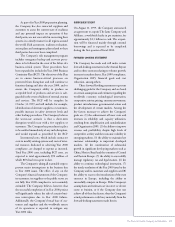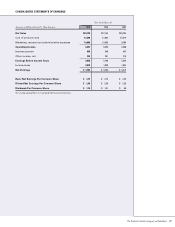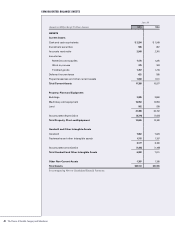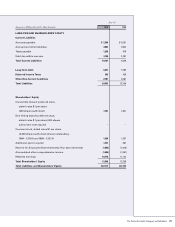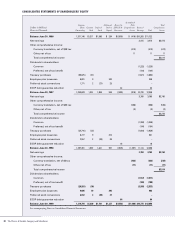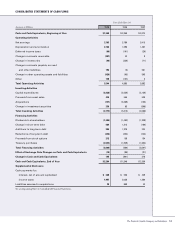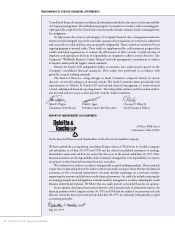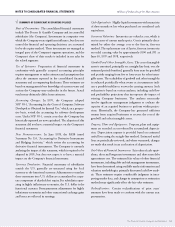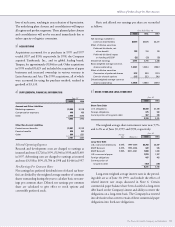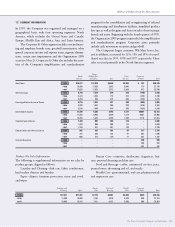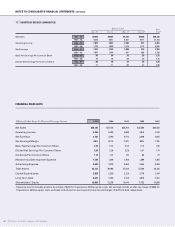Proctor and Gamble 1999 Annual Report Download - page 37
Download and view the complete annual report
Please find page 37 of the 1999 Proctor and Gamble annual report below. You can navigate through the pages in the report by either clicking on the pages listed below, or by using the keyword search tool below to find specific information within the annual report.
The Procter & Gamble Company and Subsidiaries
33
NOTES TO CONSOLIDATED FINANCIAL STATEMENTS Millions of Dollars Except Per Share Amounts
1SUMMARY OF SIGNIFICANT ACCOUNTING POLICIES
Basis of Presentation: The consolidated financial statements
include The Procter & Gamble Company and its controlled
subsidiaries (the Company). Investments in companies over
which the Company exerts significant influence, but does not
control the financial and operating decisions, are accounted
for by the equity method. These investments are managed as
integral parts of the Company’s segment operations, and the
Company’s share of their results is included in net sales for
the related segments.
Use of Estimates: Preparation of financial statements in
conformity with generally accepted accounting principles
requires management to make estimates and assumptions that
affect the amounts reported in the consolidated financial
statements and accompanying disclosures. These estimates are
based on management’s best knowledge of current events and
actions the Company may undertake in the future. Actual
results may ultimately differ from estimates.
Accounting Changes: In 1999, the Company adopted
SOP 98-1, “Accounting for the Costs of Computer Software
Developed or Obtained for Internal Use,” which, on a prospec-
tive basis, revised the accounting for software development
costs. Under SOP 98-1, certain costs that the Company has
historically expensed are now capitalized. The adoption of this
statement did not have a material impact on the Company’s
financial statements.
New Pronouncements: In June 1998, the FASB issued
Statement No. 133, “Accounting for Derivative Instruments
and Hedging Activities,” which revises the accounting for
derivative financial instruments. The Company is currently
analyzing the impact of this statement, which is required to be
adopted in 2001, but does not expect it to have a material
impact on the Company’s financial statements.
Currency Translation: Financial statements of subsidiaries
outside the U.S. generally are measured using the local
currency as the functional currency. Adjustments to translate
those statements into U.S. dollars are accumulated in a sepa-
rate component of shareholders’ equity. For subsidiaries oper-
ating in highly inflationary economies, the U.S. dollar is the
functional currency. Remeasurement adjustments for highly
inflationary economies and other transactional exchange gains
and losses are reflected in earnings.
Cash Equivalents: Highly liquid investments with maturities
of three months or less when purchased are considered cash
equivalents.
Inventory Valuation: Inventories are valued at cost, which is
not in excess of current market price. Cost is primarily deter-
mined by either the average cost or the first-in, first-out
method. The replacement cost of last-in, first-out inventories
exceeded carrying value by approximately $100 and $91 at
June 30, 1999 and 1998, respectively.
Goodwill and Other Intangible Assets: The cost of intangible
assets is amortized, principally on a straight-line basis, over the
estimated periods benefited, generally forty years for goodwill
and periods ranging from five to forty years for other intan-
gible assets. The realizability of goodwill and other intangibles
is evaluated periodically when events or circumstances indi-
cate a possible inability to recover the carrying amount. Such
evaluation is based on various analyses, including cash flow
and profitability projections that incorporate the impact of
existing Company businesses. The analyses necessarily
involve significant management judgment to evaluate the
capacity of an acquired business to perform within projec-
tions. Historically, the Company has generated sufficient
returns from acquired businesses to recover the cost of the
goodwill and other intangible assets.
Property, Plant and Equipment: Property, plant and equip-
ment are recorded at cost reduced by accumulated deprecia-
tion. Depreciation expense is provided based on estimated
useful lives using the straight-line method. Estimated useful
lives are periodically reviewed, and where warranted, changes
are made that result in an acceleration of depreciation.
Fair Values of Financial Instruments: Fair values of cash equiv-
alents, short and long-term investments and short-term debt
approximate cost. The estimated fair values of other financial
instruments, including debt and risk management instruments,
have been determined using available market information and
valuation methodologies, primarily discounted cash flow analy-
sis. These estimates require considerable judgment in inter-
preting market data, and changes in assumptions or estimation
methods may significantly affect the fair value estimates.
Reclassifications: Certain reclassifications of prior years’
amounts have been made to conform with the current year
presentation.


